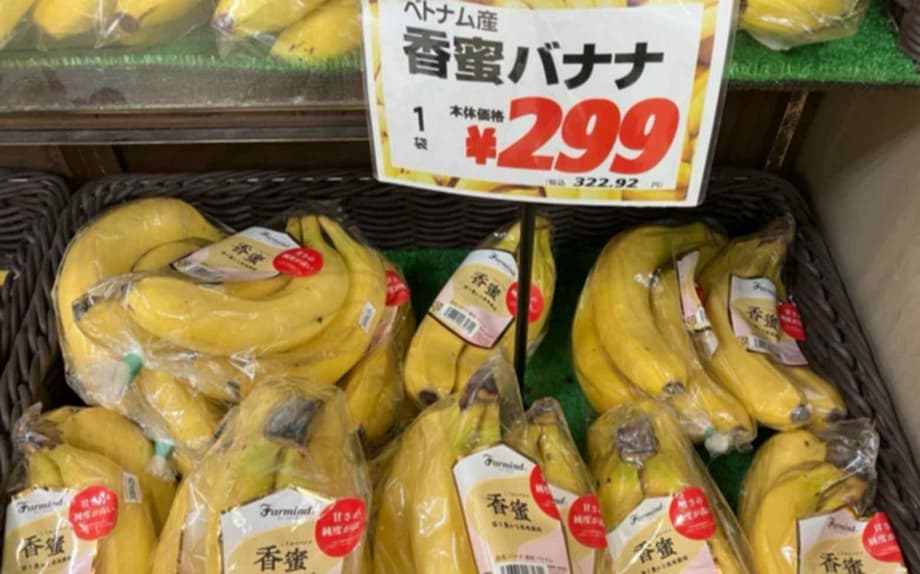Vietnamese Bananas Gain Ground in Japan: A Shift in Asia’s Banana Trade
In recent years, Japanese grocery shoppers have noticed a new contender on their fruit shelves: Vietnamese bananas. Once dominated almost entirely by imports from the Philippines, Japan’s banana market is experiencing a significant shift as Vietnamese bananas rapidly gain market share. This development is not only altering trade dynamics in Asia but also highlighting broader trends in global agriculture, trade policy, and consumer preferences.
- Vietnamese Bananas Gain Ground in Japan: A Shift in Asia’s Banana Trade
- Why Are Vietnamese Bananas Gaining Popularity in Japan?
- Vietnam’s Banana Industry: From Local Staple to Global Export
- The Philippines: Fighting to Maintain Market Share
- Regional Shifts: Vietnam’s Rise and the Impact on Asian Trade
- What’s Next for the Banana Trade in Asia?
- In Summary
Why Are Vietnamese Bananas Gaining Popularity in Japan?
Vietnam’s rise in the Japanese banana market is the result of several converging factors. According to the Vietnamese Ministry of Industry and Trade, banana exports from Vietnam to Japan surged by 62% in volume and 80.2% in value in the first seven months of 2023 compared to the same period in 2022. This rapid growth is remarkable, especially considering that Vietnamese bananas accounted for just 1.3% of Japan’s total banana imports during that time.
Japanese consumers are increasingly drawn to Vietnamese bananas for their taste and quality. Several Japanese importers have reported that their customers prefer the flavor profile of Vietnamese bananas over those from the Philippines. This shift in consumer preference is prompting major Japanese supermarket chains to increase their imports from Vietnam, even as the Philippines remains the dominant supplier.
Despite the Philippines still supplying about 75% of Japan’s bananas in 2024, this is a notable decline from the 90% market share held over a decade ago. Countries like Vietnam, Cambodia, and Peru are steadily eroding the Philippines’ dominance, thanks in part to favorable trade agreements and changing consumer tastes.
Tariffs and Trade Agreements: The Competitive Edge
One of the most significant factors behind Vietnam’s growing presence in Japan’s banana market is the difference in tariff rates. Under the ASEAN-Japan Comprehensive Economic Partnership Agreement, Vietnamese bananas have enjoyed a 0% tariff rate since April 2023, down from 3% previously. In contrast, bananas from the Philippines are still subject to tariffs ranging from 8% in the summer to 18% in the winter under the Philippines-Japan Economic Partnership Agreement (PJEPA).
This tariff disparity gives Vietnamese exporters a crucial price advantage. As the Pilipino Banana Growers and Exporters Association (PBGEA) has pointed out, lower tariffs for competitors like Vietnam make it increasingly difficult for Philippine bananas to compete on price in the Japanese market. The PBGEA has urged the Philippine government to renegotiate trade terms with Japan to level the playing field.
Japan’s trade agreements with other countries, such as Mexico and Peru, also allow those nations to export bananas at zero tariffs, further intensifying competition. The result is a more diverse banana market in Japan, with new suppliers steadily gaining ground.
Vietnam’s Banana Industry: From Local Staple to Global Export
Vietnam’s banana industry has undergone rapid transformation in recent years. In 2024, the country cultivated over 161,000 hectares of bananas, producing nearly 3 million tonnes. While China remains the largest market for Vietnamese bananas, accounting for the majority of exports, Japan, South Korea, the US, ASEAN countries, the EU, and the Middle East are all important destinations.
Vietnam’s success in expanding banana exports is rooted in several factors:
- Advanced cultivation methods: Regions like the Southeast have adopted modern farming techniques, achieving yields of up to 34.5 tonnes per hectare.
- Quality control and traceability: To meet the strict standards of markets like Japan, Vietnamese producers are increasingly investing in international safety certifications and traceability systems.
- Trade agreements: Vietnam’s participation in regional trade pacts has reduced or eliminated tariffs in key markets, making its bananas more competitive.
Despite these advances, most Vietnamese bananas are still exported fresh with minimal processing. Experts suggest that developing value-added products—such as dried banana chips or banana powder—could further boost export revenues and help Vietnamese producers avoid low-price competition.
Challenges for Vietnamese Exporters
While growth has been impressive, Vietnamese banana exporters face several hurdles. Japanese consumers are known for their high standards regarding food safety, quality, and taste. To access the Japanese market, Vietnamese bananas must be produced under strict international safety certifications, and the raw material areas must be registered and coded for traceability.
Another challenge is the demand for organic bananas. Japanese importers are increasingly interested in organic products, but large-scale organic banana production in Vietnam is limited due to persistent plant diseases that are difficult to control without conventional methods.
The Philippines: Fighting to Maintain Market Share
For decades, the Philippines has been the undisputed leader in supplying bananas to Japan. The banana industry is a vital part of the Philippine economy, generating over $1 billion in export revenues and providing livelihoods for more than 700,000 Filipinos, especially in Mindanao. However, the country’s market share in Japan has steadily declined, dropping from 90% in 2012 to 75% in 2024.
This decline is attributed to several factors:
- Tariff disadvantage: As previously mentioned, Philippine bananas face higher tariffs in Japan compared to competitors like Vietnam and Peru.
- Production challenges: The spread of diseases such as Fusarium Wilt (Panama disease) has affected banana yields, particularly among small growers.
- Geopolitical tensions: Disputes in the West Philippine Sea have strained trade relations with China, leading to a sharp drop in Philippine banana exports to that market and increasing the importance of maintaining market share in Japan.
- Competition from new suppliers: Countries like Vietnam, Cambodia, and Mexico have increased their banana production and exports, benefiting from lower tariffs and improved logistics.
Philippine officials, including Agriculture Secretary Francisco Tiu Laurel Jr., have engaged in high-level talks with Japanese counterparts to push for a review of the PJEPA and seek tariff reductions. Laurel emphasized the importance of the banana industry for poverty alleviation and job creation in Mindanao, urging Japan to consider the broader economic impact of its trade policies.
Industry Voices: The Call for Fair Competition
Philippine banana growers and exporters have been vocal about the need for fairer trade terms. The PBGEA has warned that without tariff reductions, the Philippines risks losing its competitive edge not only in Japan but also in other key markets. The group has called on the government to prioritize banana research and invest in disease management to ensure the industry’s long-term sustainability.
Japanese importers, for their part, continue to value Philippine bananas for their freshness and taste, citing the country’s proximity to Japan as an advantage. However, as tariffs and production issues persist, Japanese retailers are increasingly diversifying their sources to ensure stable supply and competitive prices.
Regional Shifts: Vietnam’s Rise and the Impact on Asian Trade
The rise of Vietnamese bananas in Japan is part of a broader regional shift in banana trade. Vietnam has also overtaken the Philippines as the top banana supplier to China, thanks to increased production, better prices, and improved logistics. Investments in Cambodia and other neighboring countries have further strengthened Vietnam’s position in the Asian banana market.
Geopolitical tensions have played a significant role in these shifts. For example, China’s imports of Philippine bananas dropped by nearly 50% in 2023 due to disputes in the West Philippine Sea. Meanwhile, Vietnam’s banana exports to China surged by 19%, capturing 42% of the market. These changes have forced Philippine exporters to diversify their markets and redouble efforts to maintain their share in Japan and South Korea.
The Importance of Trade Agreements and Logistics
Trade agreements such as the ASEAN-Japan Comprehensive Economic Partnership and the Regional Comprehensive Economic Partnership (RCEP) have facilitated the flow of bananas and other agricultural products across Asia. Improved rail and road links between Vietnam and China have reduced shipping times and costs, making Vietnamese bananas more attractive to buyers in both China and Japan.
However, as markets become more competitive, both Vietnam and the Philippines must continue to invest in quality control, disease management, and logistics infrastructure to meet the evolving demands of international buyers.
What’s Next for the Banana Trade in Asia?
The competition between Vietnam and the Philippines in Japan’s banana market is likely to intensify in the coming years. Japan plans to enforce zero tariffs on bananas from Vietnam and other exporting countries by 2028, which could further erode the Philippines’ market share unless similar concessions are granted.
For Vietnamese exporters, the challenge will be to maintain high quality and meet stringent Japanese standards while scaling up production. For the Philippines, the focus will be on negotiating better trade terms, investing in research and disease management, and diversifying export markets to reduce reliance on any single country.
Experts believe that success in the Japanese market is a strong indicator of a country’s ability to compete globally. Japanese consumers are known for their discerning tastes and high expectations for food safety and quality. If Vietnamese bananas can continue to win over Japanese shoppers, it bodes well for their prospects in other demanding markets around the world.
In Summary
- Vietnamese bananas are rapidly gaining market share in Japan, challenging the long-standing dominance of Philippine imports.
- Key factors driving this shift include favorable tariffs for Vietnamese bananas, changing consumer preferences, and increased production capacity in Vietnam.
- The Philippines’ market share in Japan has declined from 90% to 75% over the past decade, prompting calls for tariff reductions and greater investment in the banana industry.
- Regional trade agreements and improved logistics have facilitated Vietnam’s export growth, not only to Japan but also to China and other markets.
- Both Vietnam and the Philippines face challenges in maintaining quality, managing diseases, and meeting the strict standards of international buyers.
- The outcome of ongoing trade negotiations and industry investments will shape the future of banana trade in Asia and beyond.












